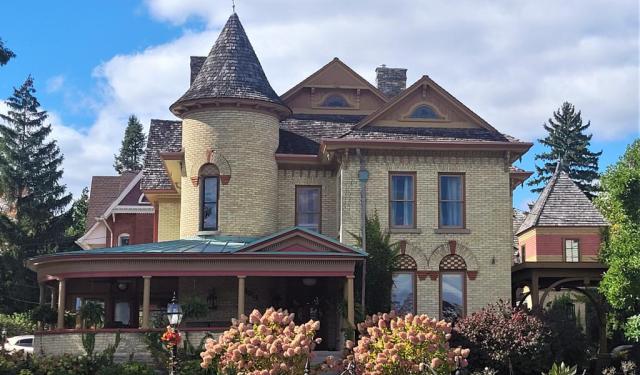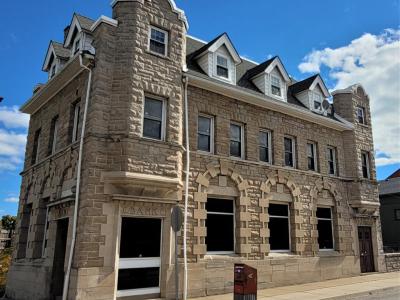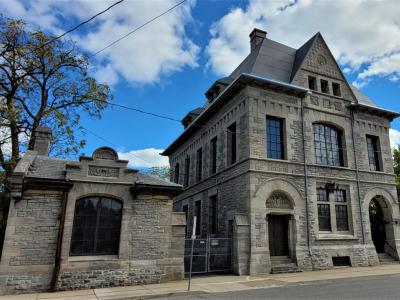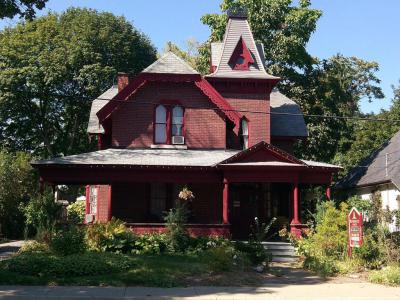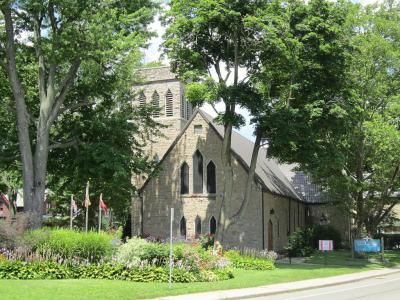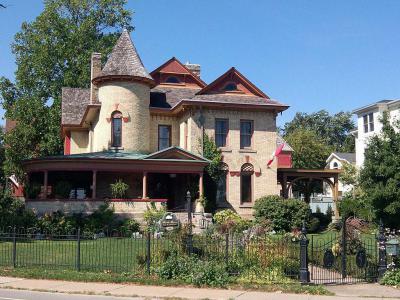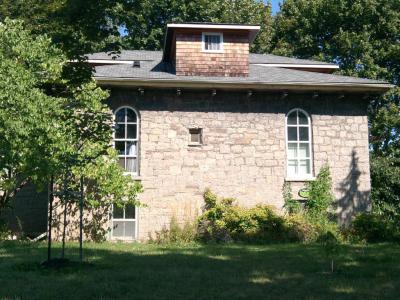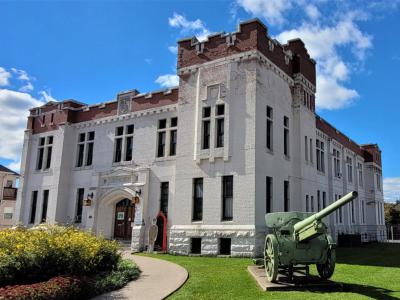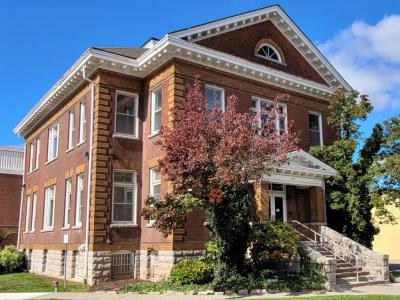Niagara Falls Historical Buildings (Self Guided), Niagara Falls
Despite being a small town, Niagara Falls, Ontario, is home to several significant pieces of historical architecture reflecting the city's unique character and heritage. Indeed, from the grand Gothic-Revival Railway Station to the charming Queen Anne-style Doran-Marshall Residence, the old buildings of Niagara Falls offer a colorful display of masonry craftsmanship whose intricate carvings, decorative details, and ornate facades can easily transport you back in time.
Just as anywhere else where they appreciate the importance of history, these buildings are a living testament to the city's storied past. The Old Imperial Bank, the Old Post Office & Customs House, the Christ Church, and other similarly eye-catching locations attract tourists who seek to learn more about Niagara Falls' background.
"Niagara Falls's historic architecture is a symphony of stone, brick, and wood," they say, with each building contributing to the city's cultural fabric. It's hard to argue with that, especially if given the likes of the Bampfield Hall, an impressive blend of Gothic Revival and Second Empire styles dating back to 1885, or a later example of Gothic Revival, the Niagara Falls Armoury, constructed in 1911.
These and other architectural gems have gracefully stood the test of time. Their stories set in stone are well worth listening to. If you want to hear them, this self-guided walking tour may be of help.
Just as anywhere else where they appreciate the importance of history, these buildings are a living testament to the city's storied past. The Old Imperial Bank, the Old Post Office & Customs House, the Christ Church, and other similarly eye-catching locations attract tourists who seek to learn more about Niagara Falls' background.
"Niagara Falls's historic architecture is a symphony of stone, brick, and wood," they say, with each building contributing to the city's cultural fabric. It's hard to argue with that, especially if given the likes of the Bampfield Hall, an impressive blend of Gothic Revival and Second Empire styles dating back to 1885, or a later example of Gothic Revival, the Niagara Falls Armoury, constructed in 1911.
These and other architectural gems have gracefully stood the test of time. Their stories set in stone are well worth listening to. If you want to hear them, this self-guided walking tour may be of help.
How it works: Download the app "GPSmyCity: Walks in 1K+ Cities" from Apple App Store or Google Play Store to your mobile phone or tablet. The app turns your mobile device into a personal tour guide and its built-in GPS navigation functions guide you from one tour stop to next. The app works offline, so no data plan is needed when traveling abroad.
Niagara Falls Historical Buildings Map
Guide Name: Niagara Falls Historical Buildings
Guide Location: Canada » Niagara Falls (See other walking tours in Niagara Falls)
Guide Type: Self-guided Walking Tour (Sightseeing)
# of Attractions: 9
Tour Duration: 1 Hour(s)
Travel Distance: 1.9 Km or 1.2 Miles
Author: Stella
Sight(s) Featured in This Guide:
Guide Location: Canada » Niagara Falls (See other walking tours in Niagara Falls)
Guide Type: Self-guided Walking Tour (Sightseeing)
# of Attractions: 9
Tour Duration: 1 Hour(s)
Travel Distance: 1.9 Km or 1.2 Miles
Author: Stella
Sight(s) Featured in This Guide:
- Via Railway Station
- Old Imperial Bank
- Old Post Office and Customs House
- Bampfield Hall
- Christ Church
- Doran-Marshall Residence
- First Bampfield House
- Niagara Falls Armoury
- Niagara Falls Carnegie Library
1) Via Railway Station
The Via Railway Station, situated in Niagara Falls, Ontario, functions as the endpoint for the GO Transit's Lakeshore West line to Toronto and the Maple Leaf train that runs between Toronto and New York City. The station building, constructed in 1879 in a Gothic Revival style, is recognized as a heritage railway station and listed on the Canadian Register of Historic Places.
In 1879, a passenger depot was destroyed by fire, and the Great Western Railroad promptly erected a new depot using red brick in a Gothic architectural style. The replacement depot consisted of a two-story central section and east and west wings that were 30 meters long each.
Initially, the station's two waiting rooms had separate entrances before they were connected in 1951. The station's ceilings were 4.6 meters high, and it had wooden plank flooring. The waiting rooms contained a center circular ticket booth and a large pot-bellied stove that heated both areas. The station also housed a restaurant/saloon known as the "Great Western Restaurant" from 1853 to 1860.
From 1879 to 1882, the station served as the Great Western Railway's terminus, and from 1923 to 1967, it was the Grand Trunk Railway's station. It was the busiest and most magnificent station owned by the railway during that time. The station underwent renovations in 1951 and was partially demolished in 1967 when the east wing, formerly used as a restaurant, was removed.
GO Transit began operating a single weekday train trip to and from Niagara Falls in January 2019, and in September 2019, the formerly summer-only weekend train service became year-round.
In 1879, a passenger depot was destroyed by fire, and the Great Western Railroad promptly erected a new depot using red brick in a Gothic architectural style. The replacement depot consisted of a two-story central section and east and west wings that were 30 meters long each.
Initially, the station's two waiting rooms had separate entrances before they were connected in 1951. The station's ceilings were 4.6 meters high, and it had wooden plank flooring. The waiting rooms contained a center circular ticket booth and a large pot-bellied stove that heated both areas. The station also housed a restaurant/saloon known as the "Great Western Restaurant" from 1853 to 1860.
From 1879 to 1882, the station served as the Great Western Railway's terminus, and from 1923 to 1967, it was the Grand Trunk Railway's station. It was the busiest and most magnificent station owned by the railway during that time. The station underwent renovations in 1951 and was partially demolished in 1967 when the east wing, formerly used as a restaurant, was removed.
GO Transit began operating a single weekday train trip to and from Niagara Falls in January 2019, and in September 2019, the formerly summer-only weekend train service became year-round.
2) Old Imperial Bank
The Old Imperial Bank in Niagara Falls, Ontario is a magnificent limestone building that has stood the test of time for over a century. Constructed in 1906, it was designed by the Toronto-based architectural firm of Darling and Pearson and features an eclectic blend of Romanesque Revival and French Renaissance styles.
The bank's central location in downtown Niagara Falls made it a significant player in the economic development of the surrounding businesses. As one of the few old commercial structures remaining in the area, the Old Imperial Bank is a remarkable symbol of the once-prosperous Village of Elgin.
The building's exterior is made of quarry-faced limestone and features massive stone sections that were deliberately designed to give the impression of strength and security. The carved door lintels and large cut stone window surrounds are also noteworthy, contributing to the building's dominant and elegant presence on the corner.
Despite a major bank robbery that occurred on the site in 1964, the Old Imperial Bank continues to stand as a solid and distinguished reminder of the downtown's earlier prosperity. The property is recognized for its heritage value by the City of Niagara Falls, and its central location near other heritage properties makes it a popular destination for tourists and locals alike.
The bank's central location in downtown Niagara Falls made it a significant player in the economic development of the surrounding businesses. As one of the few old commercial structures remaining in the area, the Old Imperial Bank is a remarkable symbol of the once-prosperous Village of Elgin.
The building's exterior is made of quarry-faced limestone and features massive stone sections that were deliberately designed to give the impression of strength and security. The carved door lintels and large cut stone window surrounds are also noteworthy, contributing to the building's dominant and elegant presence on the corner.
Despite a major bank robbery that occurred on the site in 1964, the Old Imperial Bank continues to stand as a solid and distinguished reminder of the downtown's earlier prosperity. The property is recognized for its heritage value by the City of Niagara Falls, and its central location near other heritage properties makes it a popular destination for tourists and locals alike.
3) Old Post Office and Customs House
The Old Post Office and Customs House in Niagara Falls is an impressive three-storey Romanesque Revival building that was constructed by Thomas Fuller in 1885. This building is made of limestone and exhibits a colossal presence at the corner of Park Street and Zimmerman Avenue. The building features a mansard roof with center gables on each facade and massive round-headed archways on a corner entrance that effectively creates a dual stairway.
The building is associated with Thomas Fuller, the government architect who designed the first Parliament buildings in Ottawa. The original “Zimmerman” post office, built by Samuel Zimmerman, was located on the corner of Clifton Avenue and Bridge Street, but moved in 1885 to the new Dominion Government Building. The building's dignified presence continues to impress and is a reminder of the prosperous downtown business district of the former Village of Elgin.
Sharing the building was the Customs House, which occupied the second floor. However, a furnace explosion in 1927 nearly destroyed the edifice. After temporarily relocating the services, the old building was enlarged and remodeled, and it functioned solely as a customs office.
The exterior of the building is very impressive for its time of construction and is an excellent example of many typical post offices and custom houses designed around this time by federal government architects. The building's truncated hip roof with cross gables and the quoining at all corners contribute to the commanding presence of the building. The main entrance is recessed, and the corner of the building has two magnificent round-headed arches supported by a limestone pillar with a Corinthian entablature.
The Old Post Office and Customs House is valuable to the landscape of the downtown because it is one of many heritage properties deemed significant to the development of the downtown and the wider community. The building is similar to surrounding structures in its size and age and functioned as a significant location for communication and government operations.
The building is associated with Thomas Fuller, the government architect who designed the first Parliament buildings in Ottawa. The original “Zimmerman” post office, built by Samuel Zimmerman, was located on the corner of Clifton Avenue and Bridge Street, but moved in 1885 to the new Dominion Government Building. The building's dignified presence continues to impress and is a reminder of the prosperous downtown business district of the former Village of Elgin.
Sharing the building was the Customs House, which occupied the second floor. However, a furnace explosion in 1927 nearly destroyed the edifice. After temporarily relocating the services, the old building was enlarged and remodeled, and it functioned solely as a customs office.
The exterior of the building is very impressive for its time of construction and is an excellent example of many typical post offices and custom houses designed around this time by federal government architects. The building's truncated hip roof with cross gables and the quoining at all corners contribute to the commanding presence of the building. The main entrance is recessed, and the corner of the building has two magnificent round-headed arches supported by a limestone pillar with a Corinthian entablature.
The Old Post Office and Customs House is valuable to the landscape of the downtown because it is one of many heritage properties deemed significant to the development of the downtown and the wider community. The building is similar to surrounding structures in its size and age and functioned as a significant location for communication and government operations.
4) Bampfield Hall
Bampfield Hall is a stunning two-story home located on Zimmerman Avenue in Niagara Falls, Ontario. The house is an excellent example of the Gothic Revival Style and the Second Empire Style, featuring pointed windows, a jerkinhead roof, and decorative bargeboards. The house is adorned with a bright blue exterior accented with white and yellow trim, creating a unique and recognizable appearance that sets it apart from the other buildings in the area.
The house was built in 1875 for James Bampfield's wife Margaret. James Bampfield was a prominent figure in Niagara Falls and was involved in various commercial developments in the area. His son, James Bampfield Jr., is remembered for bringing electricity to Niagara Falls and lived in the cottage next door to Bampfield Hall with his family. The Bampfield family owned the house for generations until it was sold in 1969.
Bampfield Hall's location along historic Zimmerman Avenue and its orientation towards the Niagara River make it an essential part of the area's heritage setting. The house is situated across from a beautiful church and near several buildings with unique historical character, contributing to the neighborhood's overall charm. The commercial area along Queen and Victoria Street is a short distance away, which was advantageous to the Bampfield family as they rose to prominence in commercial dealings in Niagara Falls.
Today, Bampfield Hall operates as a bed and breakfast, providing visitors with a chance to experience the unique beauty and history of the house firsthand. The house's recognition for its heritage value by the City of Niagara Falls highlights its importance in the area's history and encourages tourism to the neighborhood. The combination of its distinctive style, rich history, and current use as a bed and breakfast make Bampfield Hall a must-see attraction for visitors to Niagara Falls.
The house was built in 1875 for James Bampfield's wife Margaret. James Bampfield was a prominent figure in Niagara Falls and was involved in various commercial developments in the area. His son, James Bampfield Jr., is remembered for bringing electricity to Niagara Falls and lived in the cottage next door to Bampfield Hall with his family. The Bampfield family owned the house for generations until it was sold in 1969.
Bampfield Hall's location along historic Zimmerman Avenue and its orientation towards the Niagara River make it an essential part of the area's heritage setting. The house is situated across from a beautiful church and near several buildings with unique historical character, contributing to the neighborhood's overall charm. The commercial area along Queen and Victoria Street is a short distance away, which was advantageous to the Bampfield family as they rose to prominence in commercial dealings in Niagara Falls.
Today, Bampfield Hall operates as a bed and breakfast, providing visitors with a chance to experience the unique beauty and history of the house firsthand. The house's recognition for its heritage value by the City of Niagara Falls highlights its importance in the area's history and encourages tourism to the neighborhood. The combination of its distinctive style, rich history, and current use as a bed and breakfast make Bampfield Hall a must-see attraction for visitors to Niagara Falls.
5) Christ Church
Christ Church, built in 1865, is a charming Anglican parish located just two kilometers downstream from Niagara Falls, one of the natural wonders of the world. It is a one-story stone church with a gable roof and stunning Gothic stained glass windows. The church is part of the Diocese of Niagara and is a significant landmark in the Niagara Falls community.
The Rectory of Christ Church was constructed in 1879, and later in 1894, new transepts and a chancel were added. The original pipe organ was installed in 1895, which was replaced in 1964 in memory of parishioners who died in the two World Wars. The church halls, namely the Crysler Room and Memorial Hall, were built in 1910 and have undergone various renovations.
Christ Church is unique in Niagara Falls as it has a full ten-bell carillon, which was installed in the tower in 1912. Each bell has a name that embodies different Christian values, such as Love, Faith, Hope, Charity, Truth, Temperance, Devotion, Long Suffering, and Peace. The old tower was torn down and a new tower was built in 1935 on the southwest wall. The bells were re-hung in the new tower, and a baptistery was constructed where the old tower had been. In 1954, the baptistery became the Narthex, which is the entryway of the church.
During the 1950s, various renovations were done inside the church, including the construction of different rooms and a tunnel connecting the church to the halls. The rector's office, secretary's office, and Altar Guild Sacristy were added, and a second-story room named the MacDonald Room was also built. The MacDonald Room was renovated in 2000 and is a beautiful addition to the church.
Christ Church is an essential part of the Niagara Falls community and a testament to the dedication of its parishioners. Its rich history and beautiful architecture make it a must-see destination for anyone visiting Niagara Falls.
The Rectory of Christ Church was constructed in 1879, and later in 1894, new transepts and a chancel were added. The original pipe organ was installed in 1895, which was replaced in 1964 in memory of parishioners who died in the two World Wars. The church halls, namely the Crysler Room and Memorial Hall, were built in 1910 and have undergone various renovations.
Christ Church is unique in Niagara Falls as it has a full ten-bell carillon, which was installed in the tower in 1912. Each bell has a name that embodies different Christian values, such as Love, Faith, Hope, Charity, Truth, Temperance, Devotion, Long Suffering, and Peace. The old tower was torn down and a new tower was built in 1935 on the southwest wall. The bells were re-hung in the new tower, and a baptistery was constructed where the old tower had been. In 1954, the baptistery became the Narthex, which is the entryway of the church.
During the 1950s, various renovations were done inside the church, including the construction of different rooms and a tunnel connecting the church to the halls. The rector's office, secretary's office, and Altar Guild Sacristy were added, and a second-story room named the MacDonald Room was also built. The MacDonald Room was renovated in 2000 and is a beautiful addition to the church.
Christ Church is an essential part of the Niagara Falls community and a testament to the dedication of its parishioners. Its rich history and beautiful architecture make it a must-see destination for anyone visiting Niagara Falls.
6) Doran-Marshall Residence
The Doran-Marshall Residence in Niagara Falls, Ontario, built in 1886 by prominent businessman W.L. Doran, is a stunning two-story residence with a coach house located at the rear of the property. The house is situated on the corner of River and Ellis Street, providing a breathtaking view of the Niagara River. Its location, alongside other heritage properties, reflects the prestige and status of its former owners.
W.L. Doran was a well-known businessman and an early investor in the first electricity plant in Niagara Falls. The Dominion Suspender Company, owned by W.L. and his brother Charles, was one of the earliest manufacturing industries in the downtown area. The Doran-Marshall Residence served as an unofficial social club and was a popular spot for parties and gatherings. The adjacent coach house, with its coachman's quarters, provides a glimpse into the opulent lifestyle of the owners during that era.
The Doran-Marshall Residence is a stunning example of Queen Anne Revival-style architecture. Its cream-colored brick and sweeping curved verandah with Doric columns and a molded frieze make it a standout property. The unique rounded corner tower and multi-gabled roof with built-in cornice gutter decorated with scalloped wood shingles, dentil molding, and acorn drops under the eaves add to the distinctive features of the house. The stained glass transoms, diamond cross patterns, and multiple square panes of the windows are also noteworthy.
The coach house at the rear of the property is similarly styled, with cream-colored brick and decorative wood shingles. The Doran-Marshall Residence is an important heritage property in Niagara Falls, reflecting the social and economic history of the region.
W.L. Doran was a well-known businessman and an early investor in the first electricity plant in Niagara Falls. The Dominion Suspender Company, owned by W.L. and his brother Charles, was one of the earliest manufacturing industries in the downtown area. The Doran-Marshall Residence served as an unofficial social club and was a popular spot for parties and gatherings. The adjacent coach house, with its coachman's quarters, provides a glimpse into the opulent lifestyle of the owners during that era.
The Doran-Marshall Residence is a stunning example of Queen Anne Revival-style architecture. Its cream-colored brick and sweeping curved verandah with Doric columns and a molded frieze make it a standout property. The unique rounded corner tower and multi-gabled roof with built-in cornice gutter decorated with scalloped wood shingles, dentil molding, and acorn drops under the eaves add to the distinctive features of the house. The stained glass transoms, diamond cross patterns, and multiple square panes of the windows are also noteworthy.
The coach house at the rear of the property is similarly styled, with cream-colored brick and decorative wood shingles. The Doran-Marshall Residence is an important heritage property in Niagara Falls, reflecting the social and economic history of the region.
7) First Bampfield House
First Bampfield House is a historic house. It was named after James Bampfield, the first owner of the house, who was a significant figure in the early commercial development of Niagara Falls. Constructed in the Regency style, this two-and-a-half storey house features tall, arched windows that add to its visual appeal. The limestone block walls and high raised basement create a commanding presence, and the lawns of the house extended to River Road, providing a picturesque view of the Niagara gorge and the United States.
Built in the late 1800s by John Merral, a local lumber merchant, the First Bampfield House is a unique variant of the Regency Revival style with a perfectly square plan. Its construction is noteworthy as it was built using the earth and rubble technique without mortar, made possible by the recent invention of dynamite.
While primarily used as a single-family dwelling, the house was reputedly used as a brothel for many years during the early twentieth century. Despite this, the house remains a valuable part of Niagara Falls' architectural heritage and a reminder of the city's early development. Its location on Bampfield Street and its stunning design make it a prominent landmark in the area, attracting visitors and locals alike.
Built in the late 1800s by John Merral, a local lumber merchant, the First Bampfield House is a unique variant of the Regency Revival style with a perfectly square plan. Its construction is noteworthy as it was built using the earth and rubble technique without mortar, made possible by the recent invention of dynamite.
While primarily used as a single-family dwelling, the house was reputedly used as a brothel for many years during the early twentieth century. Despite this, the house remains a valuable part of Niagara Falls' architectural heritage and a reminder of the city's early development. Its location on Bampfield Street and its stunning design make it a prominent landmark in the area, attracting visitors and locals alike.
8) Niagara Falls Armoury
The Niagara Falls Armoury, located in Niagara Falls, Ontario, is a historical building with an important military heritage. Built in 1911, it was constructed during a time of growing tensions that ultimately led to the outbreak of the First World War just three years later. The building was part of a series of armories that were constructed across Canada to train a competent militia in response to pressure from the British and the need for domestic expansion.
Today, the Niagara Military Museum is housed within the Armoury, providing visitors with a glimpse into the military history of Niagara and Canada during World War I, World War II, and the Korean War. The museum's collection includes a wide range of historical artifacts, including uniforms, firearms, and photographs. Visitors can even try on military uniforms and hop in a World War II flight simulator to get a more immersive experience.
The Armoury is a beautiful heritage structure that features medieval castle-derived features, including stone details and decorative shields. The building is made of red brick and limestone sourced from the local area. The front of the building has a projecting entrance with a Tudor arch, while the facade is generally symmetrical. One of the crenelated parapets has been built up to form a short defensive tower, adding to the building's unique design.
While the building remained in use by the military until 1999, it was designated as a historical site in 1998. Today, the Armoury continues to serve as a training center for army cadets while housing the Niagara Military Museum.
Today, the Niagara Military Museum is housed within the Armoury, providing visitors with a glimpse into the military history of Niagara and Canada during World War I, World War II, and the Korean War. The museum's collection includes a wide range of historical artifacts, including uniforms, firearms, and photographs. Visitors can even try on military uniforms and hop in a World War II flight simulator to get a more immersive experience.
The Armoury is a beautiful heritage structure that features medieval castle-derived features, including stone details and decorative shields. The building is made of red brick and limestone sourced from the local area. The front of the building has a projecting entrance with a Tudor arch, while the facade is generally symmetrical. One of the crenelated parapets has been built up to form a short defensive tower, adding to the building's unique design.
While the building remained in use by the military until 1999, it was designated as a historical site in 1998. Today, the Armoury continues to serve as a training center for army cadets while housing the Niagara Military Museum.
9) Niagara Falls Carnegie Library
The Niagara Falls Carnegie Library, located in the historic downtown area of Niagara Falls is a two-storey red brick building that exemplifies the Beaux-Arts architectural style. Erected in 1910, the building was the sixty-seventh of one hundred and eleven Carnegie libraries built in Ontario, and provided a permanent site for the city's previously nomadic book collections. It is also linked to the historical movement which advocated free access to educational and cultural materials for all citizens. Andrew Carnegie, the philanthropist behind the Carnegie Foundation, was one of America's wealthiest men at the beginning of the 20th century and dedicated much of his time and savings to providing resource centers to cities and towns all over United States and Canada through the library grants offered by the Carnegie Foundation.
The building's architectural features, an exemplification of the Beaux-Arts style, are striking. The two-storey, red brick building features a raised limestone block basement and yellow brick quoins. The polychromatic exterior is typical of the Beaux-Arts style, used to establish a decorative element. The building is a classical display of symmetry with a centrally located main entrance and front portico with brick columns and an egg and dart motif on the trim. The library also features a central gable with a closed pediment, and entablature with flat modillions and a semi-circular fanlight. The large Venetian style windows are a dominant feature. On the interior, the floors have been laid with hard wood and finished in natural oak.
The Carnegie Library played an important role in the community's early businesses and organizations, providing an open space for instructional seminars which allowed for the expansion of skills and knowledge in the community. Although this particular library has unique qualities associated with a local vernacular, its use of Beaux-Arts style with large windows is highly comparable to the majority of the Ontario libraries that have been built from the same Carnegie Foundation grants.
The building's architectural features, an exemplification of the Beaux-Arts style, are striking. The two-storey, red brick building features a raised limestone block basement and yellow brick quoins. The polychromatic exterior is typical of the Beaux-Arts style, used to establish a decorative element. The building is a classical display of symmetry with a centrally located main entrance and front portico with brick columns and an egg and dart motif on the trim. The library also features a central gable with a closed pediment, and entablature with flat modillions and a semi-circular fanlight. The large Venetian style windows are a dominant feature. On the interior, the floors have been laid with hard wood and finished in natural oak.
The Carnegie Library played an important role in the community's early businesses and organizations, providing an open space for instructional seminars which allowed for the expansion of skills and knowledge in the community. Although this particular library has unique qualities associated with a local vernacular, its use of Beaux-Arts style with large windows is highly comparable to the majority of the Ontario libraries that have been built from the same Carnegie Foundation grants.
Walking Tours in Niagara Falls, Ontario
Create Your Own Walk in Niagara Falls
Creating your own self-guided walk in Niagara Falls is easy and fun. Choose the city attractions that you want to see and a walk route map will be created just for you. You can even set your hotel as the start point of the walk.
Niagara Falls Introduction Walking Tour
Niagara Falls, Ontario, is a Canadian twin of the U.S. city by the same name, located in Niagara County, New York, just across the Niagara River spanned by the Rainbow Bridge. The two cities are named for the same world-famous Niagara Falls, one of the most extreme, awe-inspiring waterfalls on earth.
The area of Niagara Falls was originally named "Ongiara", after the indigenous... view more
Tour Duration: 2 Hour(s)
Travel Distance: 3.3 Km or 2.1 Miles
The area of Niagara Falls was originally named "Ongiara", after the indigenous... view more
Tour Duration: 2 Hour(s)
Travel Distance: 3.3 Km or 2.1 Miles
The Most Popular Cities
/ view all
